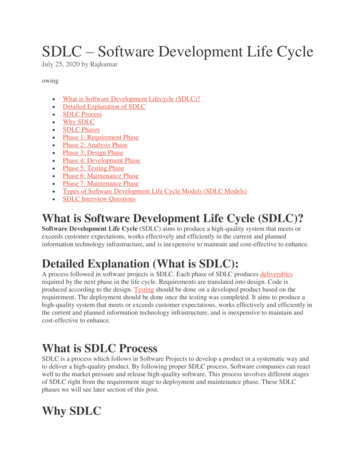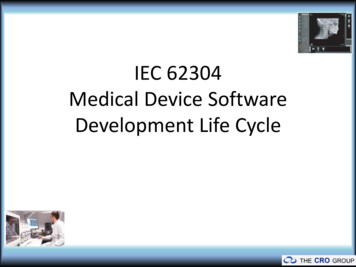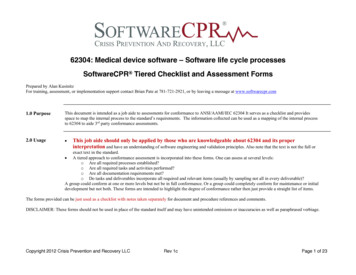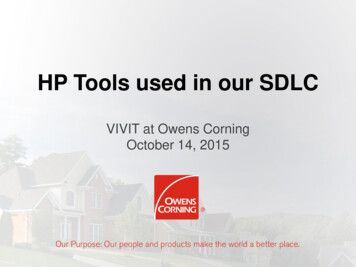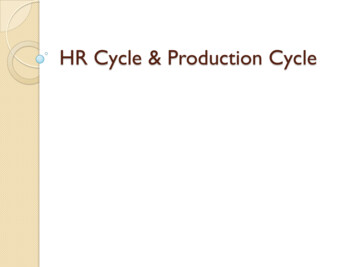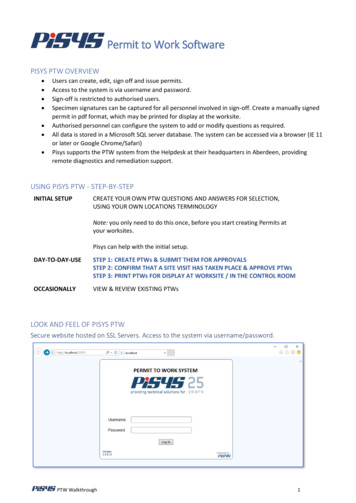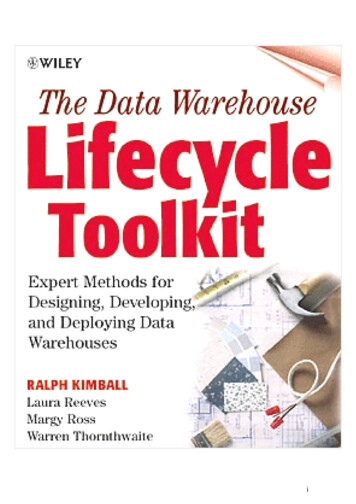
Transcription
SOFTWAREDEVELOPMENT LIFECYCLE (SDLC)
UNIT OBJECTIVE Understand the influences on a project Understand what a software process is Understand two common models
WHAT EACH PARTY CONTROLSClient SideTech SideEvery software project has three clientcontrolsThe tech team has three tySoftware Engineering is about managing the client side and defining the tech sidewhile managing risk.
MOST EVERYTHING INVOLVES TEAMS The effectiveness of the team relates directly to success Working with and within teams requires extra effort for Communication Ever play the operator game? Documentation Tooling Hand-offs (process exchanges or role turn-over) Remember, you cannot read other people’s minds
CIRCLE OF LIFE1. Teams come, operate, evolve or disband2. People come, grow, and eventuallymove on3. Projects come, grow, enter stasis orevolveYour project has to accommodate thesefacts of project life
PROJECT INFLUENCES Scale Affects the ability to know “everything” Complexity becomes a critical factor, if it wasn’t already Legacy Rarely is everything from scratch Being able to extend others’ work is essential
PROFESSIONALISMPersonal EthicsEffects Developers and administrators may have access tohighly confidential information Systems that do not work can destroy a company IPR violations can be result in fines or cease anddesist orders System abuse can paralyze a companyConfidentiality Competence Accurately reflect what you can do and accept onlywork that is within your competenceIntellectual Property Respecting confidences of employers or clientsregardless if there is a formal agreementProtecting the IP of employers and clientsMisuse Do not use skills or resources e-of-ethics
PROCESS noun pro·cessa series of actions that producesomething or that lead to a particular ocessTypical “Good” QualitiesEffectiveActually eUsableBeware: it is easy to become over-zealous or lost in process
SOFTWARE DEVELOPMENT LIFE CYCLE (SDLC) Purpose Lead to good softwareReduce riskEnable visibility and measurementEnable teaming Key attributes Outcomes/results of processes are key deliverables or products Roles are clear Pre and post conditions are understood and held true
KEY ELEMENTS IN ANY SDLC1. Feasibility2.3.4.5.SpecificationArchitecture and DesignDevelopmentValidation6. Evolution/MaintenanceThe devil is in the details of how the steps are organized and executed
The PromiseThe RealityNothing is ever as simple as it seems
PROCESS MODELS
WATERFALL MODEL (CIRCA 1968) Sequential process phases One step completes before next one startsFeasibilityAnalysisRational process Enables careful planning This is how construction is done.SpecificationGood for Feasibilitysome piece of the system cannot be easily changed (e.g.hardware)where explicit and exhaustive testing is required beforelaunchArchitecture& s Heavyweight process Meaning the process is followed systematically andcompletely (slow)Specification is a negotiation processSpecifications precede the systemWorld rarely is known upfront and evenmore rarely stays fixed DevelopmentValidationCodeTest plansand resultsHard to adapt to upstream changes once the stepcompletesEvolution &MaintenanceUpdates
WATERFALL MODEL Real projects rarely follow a sequential flow Hard to state all requirements explicitly No maintenance or evolution involved Customer must have patience Any blunder can be disastrous
BOEHM’S FIRST LAWErrors are most frequent duringrequirements and design activitiesand are more expensive the later theyare removed.
WHAT THIS MEANS IN PRACTICERelative cost of an error depending on when it is CodeUnit TestProject PhaseSystem TestField
ITERATIVE MODELS System is created by successiveversions. Go through each process step, theniterate Similar to how you are taught to write a paperIncludes feedback between steps Lowers the cost of implementingrequirement changes Allows some client/user feedback to beconsidered Smaller sized steps means delivery ofsomething comes sooner Feasibility FeasibilityAnalysisValue is created earlier It may not be clear where in theprogram the project is Changes can lead to messy designsand implementationsSpecification RequirementDocumentEvolution &MaintenanceValidation Test planandresultsArchitecture& Design DesignDocumentsDevelopment Code
AGILE MANIFESTOIndividuals and interactions overprocesses and toolsWorking software over comprehensivedocumentationCustomer collaboration over contractnegotiationResponding to change over following aplanThat is, while there is value in the itemsonthe right, we value the items on the leftmore.http://agilemanifesto.org/ This is a response to over-zealous andrigid process mongering Emphasizes getting to the right resultversus creating a lot of uselessdocuments, over-planning, or blindlyfollowing process However, this is NOT a repudiation ofdocumentation or plans.
AGILE IS A SET OF SDLC APPROACHESGlossary: RUP – Rational Unified Process https://en.wikipedia.org/wiki/Rational Unified Process XP – Extreme Programming https://en.wikipedia.org/wiki/Extreme programming DSDM - Dynamic systemsdevelopment method https://en.wikipedia.org/wiki/Dynamic systems development method FDD - Feature-driven development https://en.wikipedia.org/wiki/Featuredriven developmentBorrowed from Haresh iew-of-agile-methodology
AGILE Emphasis producing small increments of software in a reasonably short time frame Entire process is run during a sprint Sprint results are deployed Antithesis of Waterfall Plans develop incrementally and evolve Client collaboration versus client negotiation Specification follows from working system, not the reverse Immediate feedback from deployment Responding to change rather than following a plan Enhancements, new features, and bug fix are all prioritized as candidates for focusduring next sprint Emphasis on keeping scope small Although the impact of changes will grow over time“[ ] is like driving at night in the fog. You can only see as far as your headlights, butyou can make the whole trip that way.”― E.L. Doctorow, Writers At Work: The Paris Review Interviews
SCRUMEmphasis on small, semi-independent teams ideally delivering discrete pieces of a systemTeam ideally has total responsibility for the components it producesLeads to devOps models1. Team Small, cross-functional, self-organizing units2. Scope Small deliverable scope delivered in consensus priority order Priorities can be adjusted (typically at sprint start)3. Timeline Small iterations (2-3 weeks is typical) emphasizing delivery at the end
HOW SCRUM TYPICALLY OPERATESA sprint is one iteration through the processThe backlog contains all the work needing doing Includes features and other tasksUser stories describe the function from the consumer’s perspective The User may be another software component/system. You estimate how much work/time each User Story will takeThe client provides her view of the priorities in the backlog.The tech team reassesses priorities to allow for dependencies or difficultiesThe backlog is now a roadmap for the sprint or day within the sprintDaily stand-ups to discuss progress and plans for what is next A scrum-master choreographs the sprint and keeps the team focused and distractions at bay.
SCRUMIn rugby, a scrum is the way you restart the game after a minor infraction.
TEST-FIRST DESIGN Puts test specification as the criticaldesign activity Understands that deployment comeswhen the system passes testing Clearly defines what success means No more guesswork as to what“complete” means The act of defining tests requires oneto understand how the solution worksSpecificationDefinesacceptance Informs ystemDefines(non)functionobjectivesSystemunder testDeploymentDevelopment
KEY CONCERNS DRIVING IN SELECTING A PROCESS What is the net tolerance for findingerrors in deployment? How fast is the market moving? Are the teams experienced with aparticular process?Typical view ofwaterfallTypical view ofiterative Is the contract fixed and firm? When do the clients expect to seesomething?Adapted ge.htmCopyright 2003 Scott W. Ambler
EVEN WITH ADVANCES IN PROCESS, PROJECT SUCCESSREMAINS RISKYPessimist ViewOptimist ViewLeanIterativeAgileAd-HocAll projectsTraditional0234568901130% 25% 50% 75% ledStandish Group (UK), Chaos Study, 1995Dr. Dobb’s Journal 2013 IT Project Success Survey posted atwww.ambysoft.com/surveys/
WALKING THE SDLCSTEPS
FEASIBILITY Determines if a project should be attempted Usually done once at the beginning by senior (trusted) team membersFeasibility study is a proposal Does not require prototyping, but often includes itThe decision maker is the audience This person may not be sufficiently technicalIn large organizations, this can be a walk-up multiple hierarchies Budget processes and staffing usually follow from a positive response Two outcomes1.2.YeaNay
WHAT GOES INTO A FEASIBILITY STUDY1. rationalSchedule
UNCERTAINTY MAKES THIS VERY HARDChallenges Clients are unsure what they need at auseful level of detail Benefits are hard to quantify Impacts and recognizing unintendedconsequences is even harder to quantify Approach is often based on very roughguesses Organizational structures may need change Assumptions may be faultyMitigations Experience can guide process But the most experienced people maynot be the most technically current Solicit support and build interest for theproject Beware of irrational enthusiasm Leads to unreasonable expectations Senior executives rarely forget yourpromises
THE BOSS’ VIEW(ADAPTED FROM BILL ARMS)The Main Line Senior member(s) of the client’s organizationdecide whether to begin a major software project. Client: who is this project for? Scope: is it well defined? Where are theredependencies and on whom? Benefits: are the benefits real and quantifiable? Do Itrust these numbers? Technical: Is the project possible? Is there at least one technical way to carry out the project? Resources: what are the estimates of staff, time,equipment, etc.? What are the options if the project is not done?Additional Considerations Do I trust this team?Have we tried this before?Market maker? Fast follower?Is this really worth investing in?Are there IPR issues?License dependencies?Can this organization pull this off? Management capabilities Development capabilities Operational capabilities Sales capabilities
SOFTWARE DEVELOPMENT LIFE CYCLE (SDLC) Purpose Lead to good software Reduce risk Enable visibility and measurement Enable teaming Key attributes Outcomes/results of processes are key deliverables or products Roles are clear Pre and post conditions are understood and held true
